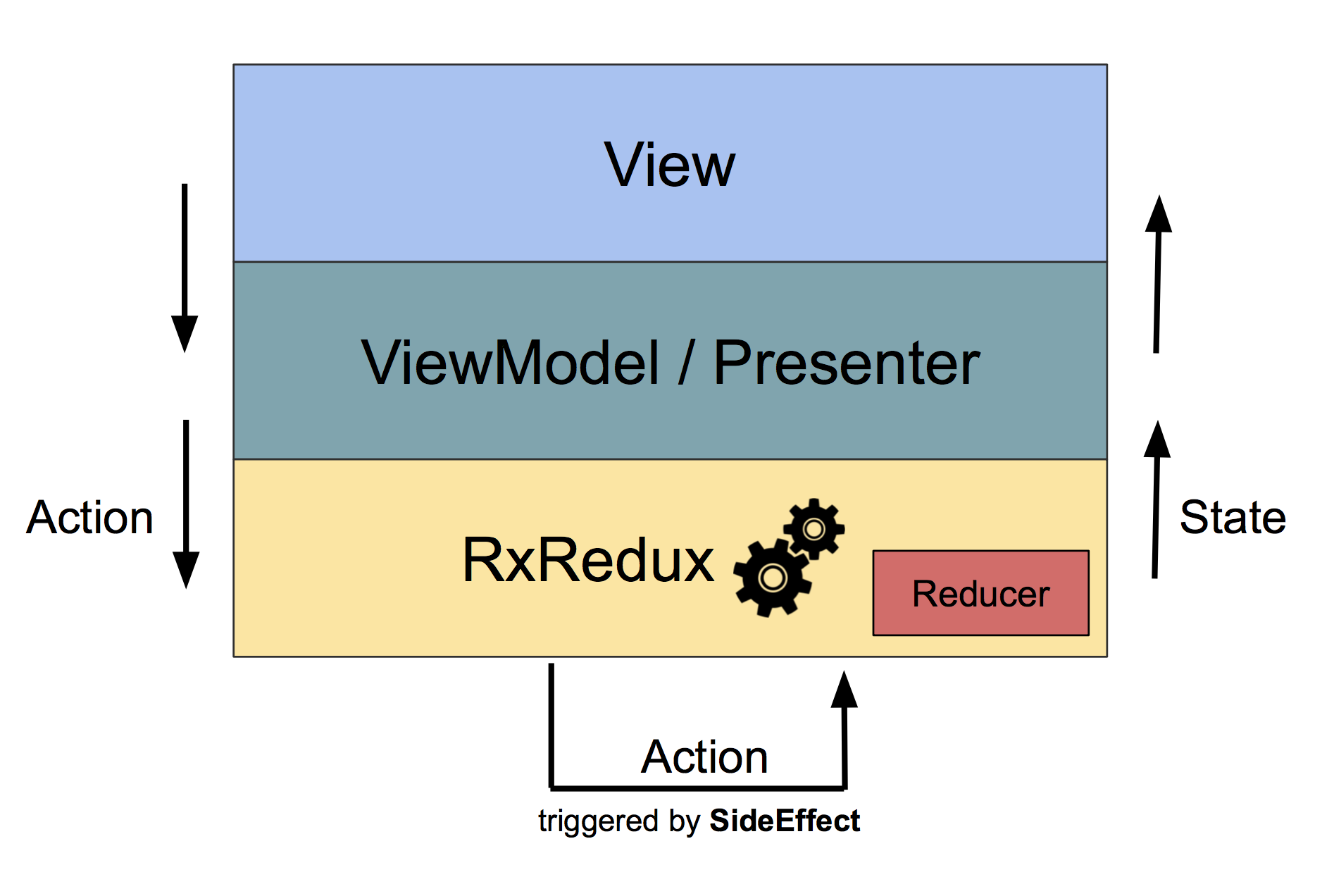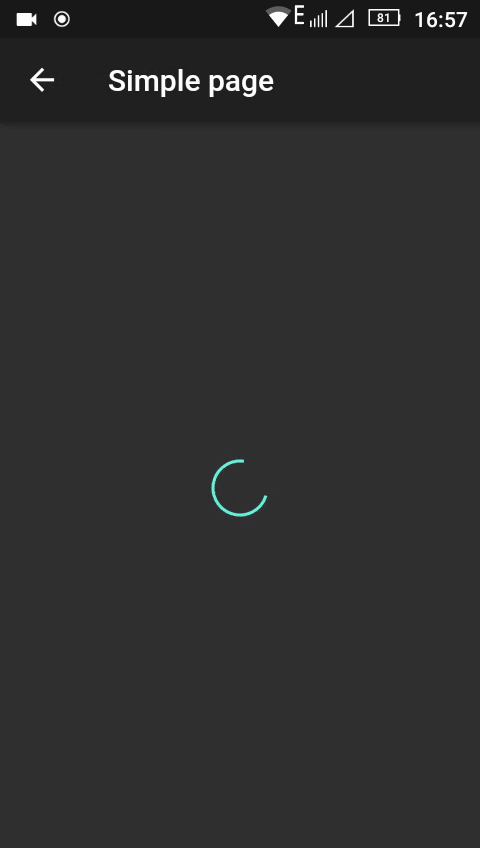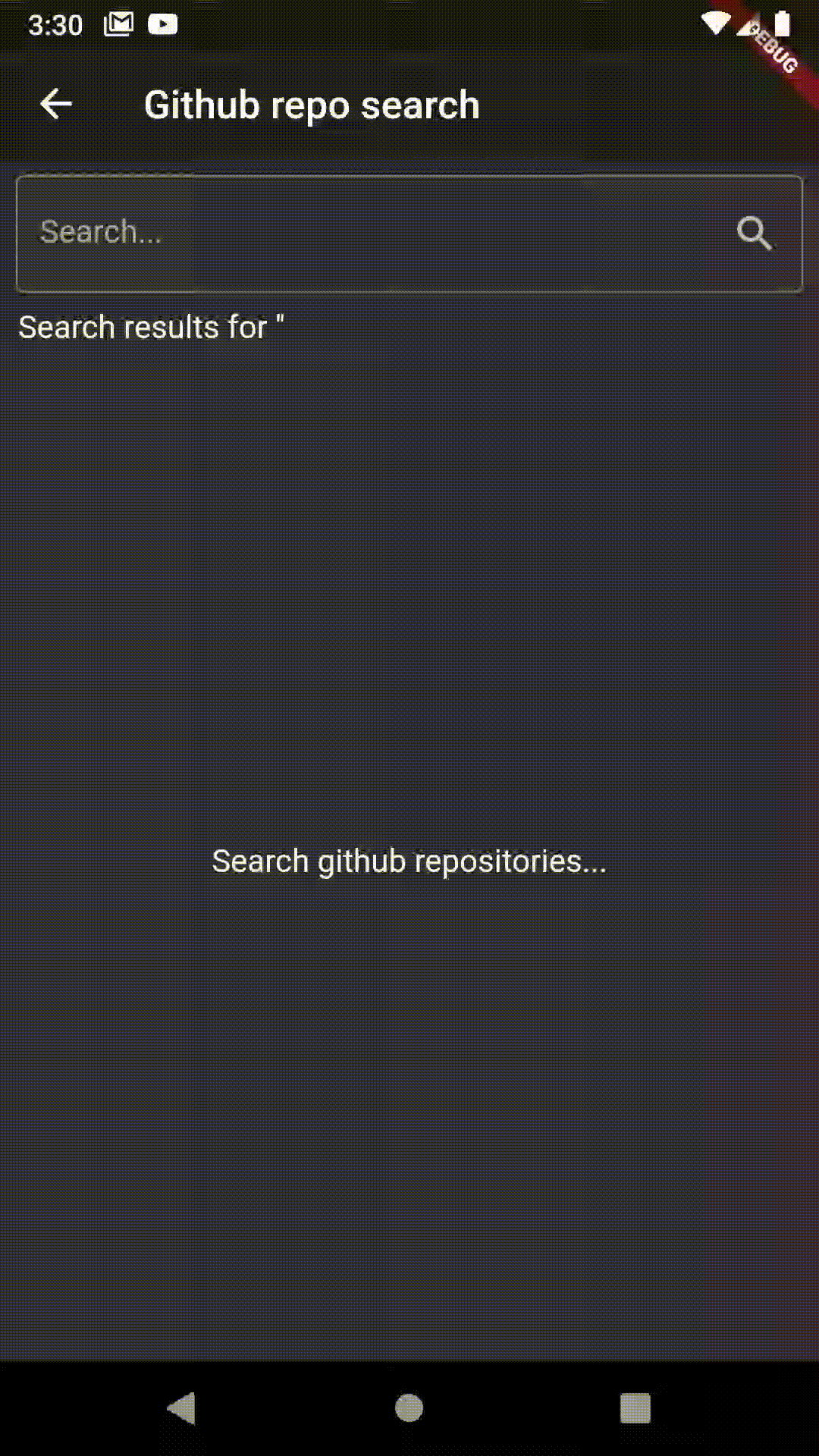rx_redux 2.5.0  rx_redux: ^2.5.0 copied to clipboard
rx_redux: ^2.5.0 copied to clipboard
Redux implementation based on Dart Stream, with the power of RxDart. Reactive redux store for Dart & Flutter.
rx_redux #
Author: Petrus Nguyễn Thái Học #

-
Reactive redux store for
Dart&Flutterinspired by RxRedux-freeletics -
A Redux store implementation entirely based on Dart
Stream, with the power ofRxDart(inspired by redux-observable) that helps to isolate side effects. RxRedux is (kind of) a replacement for RxDart's.scan()operator.


Get started #
dependencies:
rx_redux: ^2.0.0
How is this different from other Redux implementations #
In contrast to any other Redux inspired library out there, this library is pure backed on top of Dart Stream.
This library offers a custom stream transformer ReduxStoreStreamTransformer (or extension method reduxStore) and treats upstream events as Actions.
Basic concepts #
Redux Store #
-
A Store is basically an stream container for state. This library offers a custom stream transformer
ReduxStoreStreamTransformer(or extension methodreduxStore) to create such a state container. It takes aninitialStateand a list ofSideEffect<State, Action>and aReducer<State, Action>. -
Since version 2.x, add
RxReduxStoreclass, built for Flutter UI.
Action #
An Action is a command to "do something" in the store.
An Action can be triggered by the user of your app (i.e. UI interaction like clicking a button) but also a SideEffect can trigger actions.
Every Action goes through the reducer.
If an Action is not changing the state at all by the Reducer (because it's handled as a side effect), just return the previous state.
Furthermore, SideEffects can be registered for a certain type of Action.
Reducer #
A Reducer is basically a function (State, Action) -> State that takes the current State and an Action to compute a new State.
Every Action goes through the state reducer.
If an Action is not changing the state at all by the Reducer (because it's handled as a side effect), just return the previous state.
Side Effect #
A Side Effect is a function of type (Stream<Action>, GetState<State>) -> Stream<Action>.
So basically it's Actions in and Actions out.
You can think of a SideEffect as a use case in clean architecture: It should do just one job.
Every SideEffect can trigger multiple Actions (remember it returns Stream<Action>) which go through the Reducer but can also trigger other SideEffects registered for the corresponding Action.
An Action can also have a payload. For example, if you load some data from backend, you emit the loaded data as an Action like class DataLoadedAction { final Foo data; }.
The mantra an Action is a command to do something is still true: in that case it means data is loaded, do with it "something".t
GetState #
Whenever a SideEffect needs to know the current State it can use GetState to grab the latest state from Redux Store.
GetState is basically just a function () -> State to grab the latest State anytime you need it.
Selector #
Inspirited by NgRx memoized selector
-
Selectors can compute derived data, allowing Redux to store the minimal possible state.
-
Selectors are efficient. A selector is not recomputed unless one of its arguments changes.
-
When using the
select,select2toselect9,selectManyfunctions, keeps track of the latest arguments in which your selector function was invoked. Because selectors are pure functions, the last result can be returned when the arguments match without re-invoking your selector function. This can provide performance benefits, particularly with selectors that perform expensive computation. This practice is known as memoization.
Usage #
Version 2.x: Prefer to use RxReduxStore over ReduxStoreStreamTransformer, but have same concept as version 1.x #
final store = RxReduxStore(
initialState: ViewState([]),
sideEffects: [addTodoEffect, removeTodoEffect, toggleTodoEffect],
reducer: reducer,
logger: rxReduxDefaultLogger,
);
store.stateStream.listen((event) => print('~> State : $event'));
store.actionStream.listen((event) => print('~> Action: $event'));
store.dispatch(Action(Todo(i, 'Title $i', i.isEven), ActionType.add));
await store.dispose();
Note: below is the documentation for version 1.x, but have same concept as version 2.x #
Let's create a simple Redux Store for Pagination: Goal is to display a list of Persons on screen.
For a complete example check the sample application incl. README
but for the sake of simplicity let's stick with this simple "list of persons example":
1. Define State and initialState
class State {
final int currentPage;
final List<Person> persons; // The list of persons
final bool loadingNextPage;
final errorLoadingNextPage;
// constructor
// hashCode and ==
// copyWith
}
final initialState = State(
currentPage: 0,
persons: [],
loadingNextPage: false,
errorLoadingNextPage: null,
);
2. Define Actions
abstract class Action { }
// Action to load the first page. Triggered by the user.
class LoadNextPageAction implements Action {
const LoadNextPageAction();
}
// Persons has been loaded
class PageLoadedAction implements Action {
final List<Person> personsLoaded;
final int page;
// constructor
}
// Started loading the list of persons
class LoadPageAction implements Action {
const LoadPageAction();
}
// An error occurred while loading
class ErrorLoadingNextPageAction implements Action {
final error;
// constructor
}
3. Define SideEffects
// SideEffect is just a type alias for such a function:
Stream<State> loadNextPageSideEffect (
Stream<Action> actions,
GetState<State> state,
) =>
actions
// This side effect only runs for actions of type LoadNextPageAction
.whereType<LoadNextPageAction>()
.switchMap((_) {
// do network request
final State currentState = state();
final int nextPage = state.currentPage + 1;
return backend
.getPersons(nextPage)
.map<Action>((List<Person> person) {
return PageLoadedAction(
personsLoaded: persons,
page: nextPage
);
})
.onErrorReturnWith((error) => ErrorLoadingNextPageAction(error))
.startWith(const LoadPageAction());
});
4. Define Reducer
// Reducer is just a type alias for a function
State reducer(State state, Action action) {
if (action is LoadPageAction) {
return state.copyWith(loadingNextPage: true);
}
if (action is ErrorLoadingNextPageAction) {
return state.copy(
loadingNextPage: false,
errorLoadingNextPage: action.error,
);
}
if (action is PageLoadedAction) {
return state.copy(
loadingNextPage: false,
errorLoadingNextPage: null
persons: [...state.persons, ...action.persons],
page: action.page,
);
}
// Reducer is actually not handling this action (a SideEffect does it)
return state;
}
5. Combine all it into one
- Using
ReduxStoreStreamTransformer:
final Stream<Action> actions = PublishSubject<Action>();
final List<SideEffect<State, Action> sideEffects = [loadNextPageSideEffect, ...];
actions.transform(
ReduxStoreStreamTransformer<Action, State>(
initialStateSupplier: () => initialState,
sideEffects: sideEffects,
reducer: reducer,
),
).listen(view.render);
- Using extension method
reduxStore:
actions.reduxStore(
initialStateSupplier: () => initialState,
sideEffects: sideEffects,
reducer: reducer,
).listen(view.render);
- Using
RxReduxStore:
final store = RxReduxStore(
initialState: initialState,
sideEffects: sideEffects,
reducer: reducer,
logger: rxReduxDefaultLogger,
errorHandler: (error, st) => print('$error, $st'),
);
store.stateStream.listen(view.render);
Action action = ...;
store.dispatch(action);
6. More details
The following video (click on it) illustrates the workflow:
-
Let's take a look at the following illustration: The blue box is the
View(think UI). ThePresenterorViewModelhas not been drawn for the sake of readability but you can think of having such additional layers between View and Redux State Machine. The yellow box represents aStore. The grey box is thereducer. The pink box is aSideEffectAdditionally, a green circle representsStateand a red circle represents anAction(see next step). On the right you see a UI mock of a mobile app to illustrate UI changes. -
NextPageActiongets triggered from the UI (by scrolling at the end of the list). EveryActiongoes through thereducerand allSideEffectsregistered for this type of Action. -
Reduceris not interested inNextPageAction. So whileNextPageActiongoes through the reducer, it doesn't change the state. -
loadNextPageSideEffect(pink box), however, cares aboutNextPageAction. This is the trigger to run the side-effect. -
So
loadNextPageSideEffecttakesNextPageActionand starts doing the job and makes the http request to load the next page from backend. Before doing that, this side effect starts with emittingLoadPageAction. -
ReducertakesLoadPageActionemitted from the side effect and reacts on it by "reducing the state". This meansReducerknows how to react onLoadPageActionto compute the new state (showing progress indicator at the bottom of the list). Please note that the state has changed (highlighted in green) which also results in changing the UI (progress indicator at the end of the list). -
Once
loadNextPageSideEffectgets the result back from backend, the side effect emits a newPageLoadedAction. This Action contains a "payload" - the loaded data.
class PageLoadedAction implements Action {
final List<Person> personsLoaded;
final int page;
}
- As any other Action
PageLoadedActiongoes through theReducer. The Reducer processes this Action and computes a new state out of it by appending the loaded data to the already existing data (progress bar also is hidden).
Final remark:
This system allows you to create a plugin in system of SideEffects that are highly reusable and specific to do a single use case.

Also SideEffects can be invoked by Actions from other SideEffects.
For a complete example check the sample application incl. README
Examples #
| Pagination list (load more) (endless scrolling) | Flutter github search using rx_redux |
|---|---|
 |
 |
FAQ #
I get a StackOverflowError #
This is a common pitfall and is most of the time caused by the fact that a SideEffect emits an Action as output that it also consumes from upstream leading to an infinite loop.
final SideEffect<State, Int> sideEffect = (actions, state) => actions.map((i) => i * 2);
final inputActions = Stream.value(1);
inputActions.reduxStore(
initialStateSupplier: () => 'InitialState',
sideEffects: [sideEffect],
reducer: (state, action) => newState,
);
The problem is that from upstream we get Int 1.
But since SideEffect reacts on that action Int 1 too, it computes 1 * 2 and emits 2, which then again gets handled by the same SideEffect 2 * 2 = 4 and emits 4, which then again gets handled by the same SideEffect 4 * 2 = 8 and emits 8, which then getst handled by the same SideEffect and so on (endless loop) ...
Who processes an Action first: Reducer or SideEffect #
Since every Action runs through both Reducer and registered SideEffects this is a valid question.
Technically speaking Reducer gets every Action from upstream before the registered SideEffects.
The idea behind this is that a Reducer may have already changed the state before a SideEffect start processing the Action.
For example let's assume upstream only emits exactly one Action (because then it's simpler to illustrate the sequence of workflow):
// 1. upstream emits events
final upstreamActions = Stream.value(SomeAction());
SideEffect<State, Action> sideEffect1 = (actions, state) {
// 3. Runs because of SomeAction
return actions.where((a) => a is SomeAction).mapTo(OtherAction());
};
SideEffect<State, Action> sideEffect2 = (actions, state) {
// 5. Runs because of OtherAction
return actions.where((a) => a is OtherAction).mapTo(YetAnotherAction());
};
upstreamActions.reduxStore(
initialStateSupplier: () => initialState,
sideEffects: [sideEffect1, sideEffect2],
reducer: (state, action) {
// 2. This runs first because of SomeAction
...
// 4. This runs again because of OtherAction (emitted by SideEffect1)
...
// 6. This runs again because of YetAnotherAction emitted from SideEffect2)
}
).listen(print);
So the workflow is as follows:
- Upstream emits
SomeAction reducerprocessesSomeActionSideEffect1reacts onSomeActionand emitsOtherActionas outputreducerprocessesOtherActionSideEffect2reacts onOtherActionand emitsYetAnotherActionreducerprocessesYetAnotherAction
Can I use variable and function for SideEffects or Reducer #
Absolutely. SideEffect is just a type alias for a function typedef Stream<A> SideEffect<S, A>(Stream<A> actions, GetState<S> state);.
In Dart you can use a lambda for that like this:
SideEffect<State, Action> sideEffect1 = (actions, state) {
return actions
.where((a) => a is SomeAction)
.mapTo(OtherAction());
};
of write a function (instead of a lambda):
Stream<Action> sideEffect2(
Stream<Action> actions,
GetState<State> state,
) {
return actions
.where((a) => a is SomeAction)
.mapTo(OtherAction());
}
Both are totally equal and can be used like that:
upstreamActions.reduxStore(
initialStateSupplier: () => initialState,
sideEffects: [sideEffect1, sideEffect2],
reducer: (state, action) => newState,
).listen(...);
The same is valid for Reducer. Reducer is just a type alias for a function typedef S Reducer<S, A>(S currentState, A newAction);
You can define your reducer as lambda or function:
final reducer = (State state, Action action) => /*return new state*/;
// or
State reducer(State state, Action action) {
// return new state
}
Is distinct (More commonly known as distinctUntilChanged in other Rx implementations) considered as best practice #
Yes it is because reduxStore(...) is not taking care of only emitting state that has been changed
compared to previous state.
Therefore, .distinct() is considered as best practice.
actions
.reduxStore( ... )
.distinct()
.listen(view.render);
What if I would like to have a SideEffect that returns no Action #
For example, let's say you just store something in a database, but you don't need a Action as result
piped backed to your redux store. In that case you can simple use Stream.empty() like this:
Stream<Action> saveToDatabaseSideEffect(Stream<Action> actions, GetState<State> getState) {
return actions.flatMap((_) async* {
await saveToDb(something);
// not emit any Action
});
}
How do I cancel ongoing SideEffects if a certain Action happens #
Let's assume you have a simple SideEffect that is triggered by Action1.
Whenever Action2 is emitted our SideEffect should stop.
In RxDart this is quite easy to do by using: .takeUntil()
mySideEffect(Stream<Action> actions, GetState<State> getState) =>
actions
.whereType<Action1>()
.flatMap((_) => doSomething())
.takeUntil(actions.whereType<Action2>()); // Once Action2 triggers the whole SideEffect gets canceled.
Do I need an Action to start observing data #
Let's say you would like to start observing a database right from the start inside your Store. This sounds pretty much like as soon as you have subscribers to your Store and therefore you don't need a dedicated Action to start observing the database.
Stream<Action> observeDatabaseSideEffect(Stream<Action> _, GetState<State> __) =>
database // please notice that we don't use Stream<Action> at all
.queryItems()
.map((items) => DatabaseLoadedAction(items));
Features and bugs #
Please file feature requests and bugs at the issue tracker.



